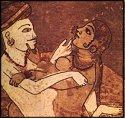Janavashya of Kallarasa
A Brief Note on Kannada Erotic Work
Janavashya
by Jyotsna Kamat
First Online: June 01, 2004
Page Last Updated: December 07, 2024
Kamashastra of Vatsyayana the oldest treatise on erotic science in the world, is a work of 1st century A.D. Being written in aphoristic form it was difficult for laymen to understand. Simpler works based on it appeared subsequently. Important and better known is 'Ratirahasya'. Rati is wife of God Kama. 'Rati' in Sanskrit stands for copulation as well. Preference is given to Rati instead of Kama her divine husband, indicating thereby, the leading role of a woman in love-play.
'Ratirahasya' became immensely popular. It is translated in many Indian languages besides Arabic, Persian and Turkish. Kallarasa tried to make his work more homely. The inquisitive young wife asks her husband to teach her lessons in love. It is in narrative form. The husband responds to query in a methodical way.
The work is divided into thirteen chapters. The subjects dealt are traditional but simpler and convincing. The classification of women into four categories. This is to help arousal. Nuances of gestures and touches, importance of foreplay, various postures, ways of winning a partner, role of courtesans and need for medication to have healthy sex, are noteworthy.
Kallarasa describes twelve ways of hugging and twelve ways of kissing. Description of an ideal bedroom and requirements are mentioned.
As regards postures, it may be remembered that several temples in Karnataka have erotic poses on the outer walls, proving that they were in vogue. In an age of polygamy (at times polyandry as well), kings, nobles and aristocracy had to cope with large harems. One man was obliged to please more than on partner and had to develop techniques to please all simultaneously! Postures after animals like bull, elephant, deer, hare and even frog were in vogue. Such postures helped individuals with special leanings and body-constitution, to derive complete sexual satisfaction.
Though courtesans were recognized as essential part of high society and necessary evil, extra marital (paradara) relations were forbidden. It is rather to educate people and guard women against evil forces. The author justifies inclusion of the topic on courtesans.
'Janavasya' was composed mainly for the welfare of the society as a whole. The ultimate goal of human life was liberation (moksha) of the soul and after dharma and artha, kama or fulfillment of all types of desire contributed to healthy family life. Since healthy families contributed to the strong state, right from Manu's days, a householder's life and its requirements was given prime importance in Hindu society.
'Janavasya' is in old Kannada. The text is proficiently edited by G.G. Manjunath of Mysore University. It is brought out as a publication of Center of Kannada studies of Mysore University after a critical and comparative study of seven available palm-leaf scripts. It would have been more helpful if prose translation in modern Kannada was also included. Fortunately, prose version of Kakkoka's 'Ratirahasya' by an anonymous writer of the 19th century is included in the book. This helps in a comparative study of Janavashya and Ratirahasya.
Reference
Kallarasa Virachita Janavasya Ed: G.G. Manjunathan. Kannada Adhyayana Samsthe, University of Mysore, Mysore 1974.
![]()

